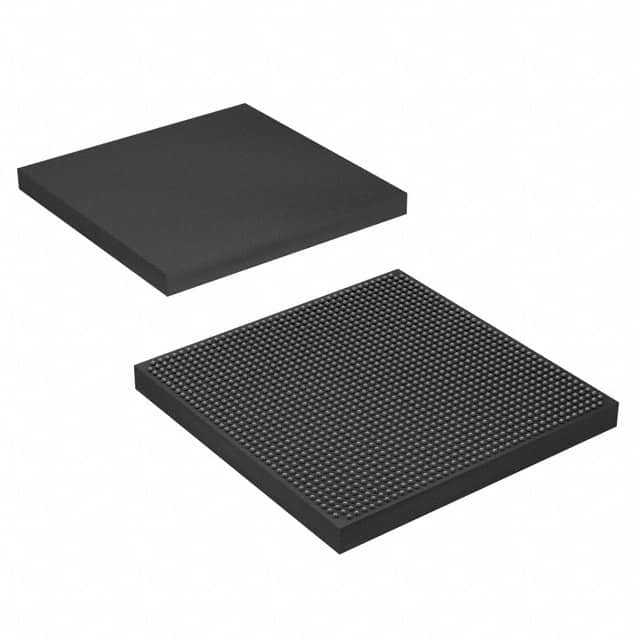5SGXEB5R2F40I2N
Product Overview
Category
The 5SGXEB5R2F40I2N belongs to the category of Field Programmable Gate Arrays (FPGAs).
Use
FPGAs are integrated circuits that can be programmed and reprogrammed to perform various digital functions. The 5SGXEB5R2F40I2N is specifically designed for high-performance applications.
Characteristics
- High-performance FPGA with advanced features
- Large capacity and high-speed processing capabilities
- Flexible and customizable design options
- Low power consumption
- Robust and reliable performance
Package
The 5SGXEB5R2F40I2N comes in a compact and durable package, ensuring easy handling and protection during transportation and installation.
Essence
The essence of the 5SGXEB5R2F40I2N lies in its ability to provide a versatile and powerful platform for implementing complex digital systems.
Packaging/Quantity
The 5SGXEB5R2F40I2N is typically packaged individually and is available in various quantities depending on customer requirements.
Specifications
- FPGA Family: Stratix V
- Logic Elements: 462,000
- Embedded Memory: 25,920 Kbits
- DSP Blocks: 1,288
- Maximum User I/Os: 622
- Operating Voltage: 1.0V
- Operating Temperature Range: -40°C to +100°C
- Package Type: F40
- Package Pins: 1517
Detailed Pin Configuration
For a detailed pin configuration diagram of the 5SGXEB5R2F40I2N, please refer to the official datasheet provided by the manufacturer.
Functional Features
- High-speed data processing capabilities
- Support for various communication protocols
- On-chip memory for efficient data storage and retrieval
- Flexible I/O options for interfacing with external devices
- Built-in security features to protect sensitive information
Advantages and Disadvantages
Advantages
- High-performance computing capabilities
- Flexibility in design and customization
- Low power consumption compared to alternative solutions
- Reliable and robust operation
- Support for advanced features and protocols
Disadvantages
- Higher cost compared to traditional microcontrollers
- Steeper learning curve for programming and utilizing the FPGA's full potential
- Limited availability of specialized technical support
Working Principles
The 5SGXEB5R2F40I2N operates based on the principles of reconfigurable logic. It consists of a matrix of programmable logic blocks interconnected by configurable routing channels. The user can program the FPGA to implement desired digital functions by configuring the interconnections and functionality of these logic blocks.
Detailed Application Field Plans
The 5SGXEB5R2F40I2N finds applications in various fields, including: 1. Telecommunications: High-speed data processing for network infrastructure equipment. 2. Aerospace and Defense: Radar systems, signal processing, and communication equipment. 3. Industrial Automation: Control systems, robotics, and machine vision. 4. Medical Devices: Imaging systems, diagnostic equipment, and patient monitoring devices. 5. Automotive: Advanced driver-assistance systems (ADAS), infotainment systems, and engine control units.
Detailed and Complete Alternative Models
- Xilinx Virtex UltraScale+ VU9P: Similar high-performance FPGA with large capacity and advanced features.
- Intel Cyclone 10 GX: Lower-cost FPGA with moderate performance suitable for mid-range applications.
- Lattice ECP5: Energy-efficient FPGA with low power consumption and compact form factor.
Note: This is not an exhaustive list, and there are several other alternative models available in the market.
Word count: 550 words
Lista 10 Vanliga frågor och svar relaterade till tillämpningen av 5SGXEB5R2F40I2N i tekniska lösningar
Sure! Here are 10 common questions and answers related to the application of 5SGXEB5R2F40I2N in technical solutions:
Q: What is the 5SGXEB5R2F40I2N FPGA used for? A: The 5SGXEB5R2F40I2N is a Field-Programmable Gate Array (FPGA) that can be used for various applications such as high-performance computing, networking, and signal processing.
Q: What are the key features of the 5SGXEB5R2F40I2N FPGA? A: Some key features include a large number of logic elements, high-speed transceivers, embedded memory blocks, and support for various communication protocols.
Q: Can the 5SGXEB5R2F40I2N FPGA be reprogrammed? A: Yes, FPGAs are designed to be reprogrammable, allowing users to modify the functionality of the device even after it has been deployed.
Q: How can the 5SGXEB5R2F40I2N FPGA be programmed? A: The 5SGXEB5R2F40I2N FPGA can be programmed using hardware description languages (HDLs) such as VHDL or Verilog, or through graphical programming tools provided by the FPGA manufacturer.
Q: What are some typical applications of the 5SGXEB5R2F40I2N FPGA? A: This FPGA can be used in applications like high-frequency trading, video processing, software-defined networking, radar systems, and data center acceleration.
Q: Does the 5SGXEB5R2F40I2N FPGA support high-speed interfaces? A: Yes, this FPGA has built-in high-speed transceivers that support protocols like PCIe, Ethernet, and USB, making it suitable for applications requiring fast data transfer.
Q: Can the 5SGXEB5R2F40I2N FPGA interface with other components or devices? A: Yes, the FPGA can interface with various components and devices through its GPIO pins, memory interfaces, and high-speed transceivers.
Q: What is the power consumption of the 5SGXEB5R2F40I2N FPGA? A: The power consumption of the FPGA depends on the design and utilization. It is recommended to refer to the device datasheet for specific power consumption details.
Q: Are there any development kits available for the 5SGXEB5R2F40I2N FPGA? A: Yes, the FPGA manufacturer provides development kits that include the necessary hardware and software tools to facilitate the design and testing process.
Q: Can the 5SGXEB5R2F40I2N FPGA be used in safety-critical applications? A: While FPGAs can be used in safety-critical applications, additional measures such as redundancy and fault-tolerant designs may be required to ensure reliability and compliance with safety standards.
Please note that the answers provided here are general and may vary depending on the specific requirements and use cases of the application.


